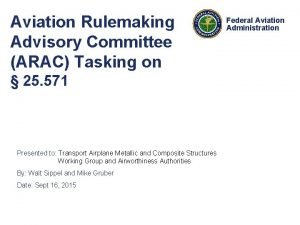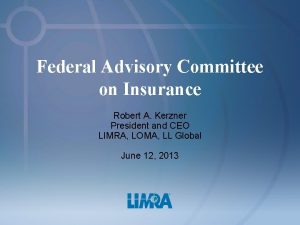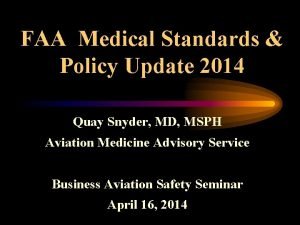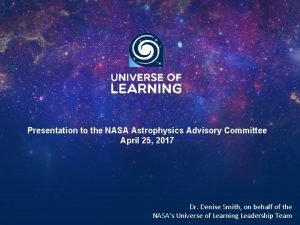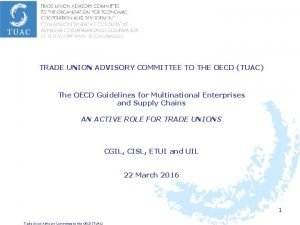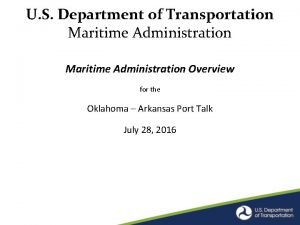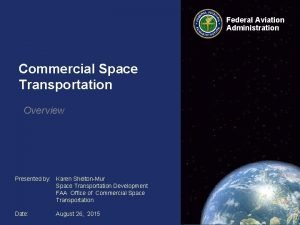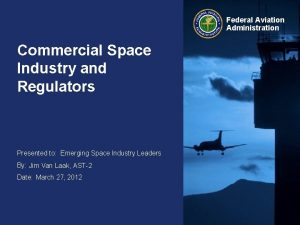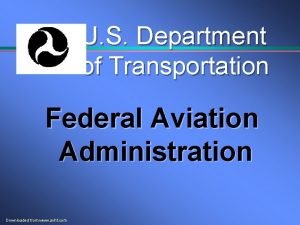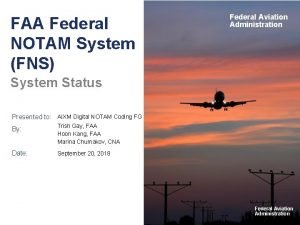Federal Aviation Administration Commercial Space Transportation Advisory Committee









- Slides: 9

Federal Aviation Administration Commercial Space Transportation Advisory Committee Systems Working Group Final Report May 11, 2012

Federal Aviation Administration Scheduled Time Systems Working Group Agenda Topic Presenter 8: 30 – 8: 40 (10 minutes) 8: 40 – 9: 00 (20 minutes) Welcome and Introductions Holder, Chair Lessons Learned Database Update Mike Kelly, Chief Engineer, FAA/AST 9: 00 – 10: 00 (60 minutes Human Spaceflight Requirements Team Status (Approach, ground rules, and assumptions Pam Melroy, Senior Technical Advisor, FAA/AST 10: 00 – 10: 20 (20 minutes) Suborbital Market Report Update Kate Maliga, Tauri Group 10: 20 – 10: 30 (10 minutes) Summation and Questions Holder, Chair

Federal Aviation Administration Systems Working Group The Systems Working Group (SWG) identifies and analyzes key safety, technical, policy, and regulatory issues concerning the range of hardware and software involved with commercial space transportation. This will include both expendable launch vehicles and reusable launch vehicles.

Federal Aviation Administration Lessons Learned Database Background • During October 2011 meeting, COMSTAC developed the following finding “COMSTAC finds that it would be beneficial for the FAA to develop a process for disclosing to the industry pertinent data from reported safety critical anomalies, mishaps, incidents, and precursors where relevant to current and future operations. Such a process needs to protect proprietary data and comply with relevant export control policies whiles still fostering the continuous safety improvement of the industry” • Subsequently, the House Subcommittee on Space and Aeronautics asked AST: “Do you have a model in mind for a system to exchange lessons learned data between government and industry? ” 4

Federal Aviation Administration Lessons Learned Database • Observations SWG O 1 - CSTLLS Database has gone largely unpopulated and unused. Companies that share data with AST have not been willing to share with other companies • Recommendations SWG R 1 – COMSTAC recommends AST work with COMSTAC to look at a framework for data sharing.

Federal Aviation Administration Human Spaceflight Requirements - Background • When regulations are required, it will be a major undertaking several years to assemble them • Best practices are out there – we can and should begin the work to collect them, organize them, and think about how they might be structured in the future • AST is motivated by the concern that if a mishap occurs, an emergency rulemaking will be mandated…. if unprepared, a rushed response may result in poor quality regulations • The process is only just beginning and nothing is cast in stone • The process will take significant time, so the discussion must start now if we want a quality product • AST wants to engage industry early through COMSTAC, and continuously every step of the way – as much as permitted by law

Federal Aviation Administration Human Spaceflight Requirements - Background Need Statement A set of regulations which neither stifle technology development nor expose occupants to avoidable risks. Our goals are to develop a set of regulations that: 1. 2. 3. 4. 5. 6. 7. 8. Protect occupants from avoidable risks. Leverage existing knowledge of human spaceflight safety. Are easily understood. Are performance-based to the greatest extent possible. Are applicable to all known likely system designs/uses Do not restrict innovation. Will minimize cost burden on industry. Will be easily updated with new knowledge and as technology evolves.

Federal Aviation Administration Human Spaceflight Requirements • Observations SWG O 2 - COMSTAC finds that the Administrative Procedures Act restrictions present challenges to rulemaking • Recommendations SWG R 2 - COMSTAC recommends AST continue to work with industry to assess and develop human spaceflight requirements. These interactions should include face to face meetings and telephone calls with COMSTAC members.

Federal Aviation Administration Suborbital Market Report Background • 10 year forecast of markets for launches of reusable suborbital vehicles • Effort is jointly funded by FAA and Space Florida • Builds on Spring 2011 Suborbital Market Characterization study and Fall 2011 FAA Suborbital Report – Those studies identified & characterized 7 market segments for suborbital vehicles and summarized suborbital suppliers – This study adds an 8 th market, Satellite/UAV Deployment, which is for payloads launched or inserted from the suborbital vehicle – This study takes those markets and conducts demand-based forecasts for each market segment – Market forecasts are combined to develop a consolidated 10 year forecast and evaluated against the forecasted supply 9
 Aviation rulemaking advisory committee
Aviation rulemaking advisory committee Robert kerzner
Robert kerzner Federal aviation administration purpose
Federal aviation administration purpose What is an advisory circular in aviation
What is an advisory circular in aviation Aviation medicine advisory service
Aviation medicine advisory service Nasa astrophysics advisory committee
Nasa astrophysics advisory committee Who was the advocator of learning without burden
Who was the advocator of learning without burden Trade union advisory committee
Trade union advisory committee Commercial aviation safety team
Commercial aviation safety team Us department of transportation maritime administration
Us department of transportation maritime administration
